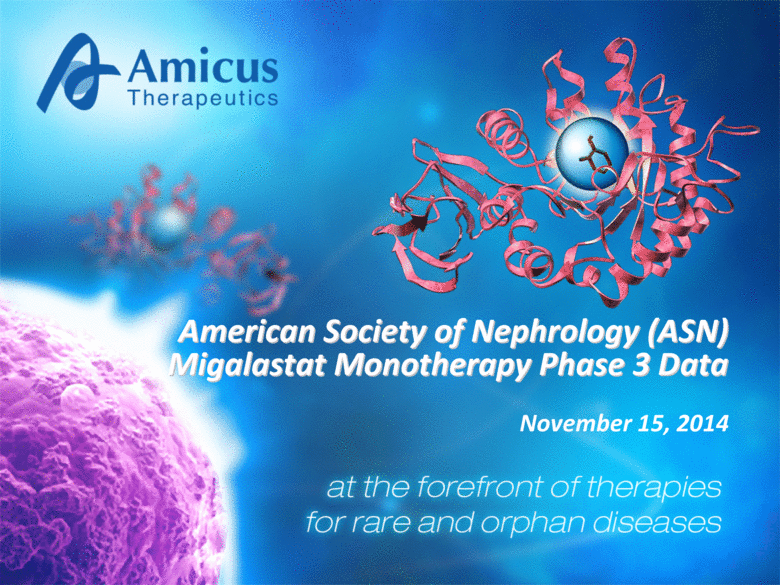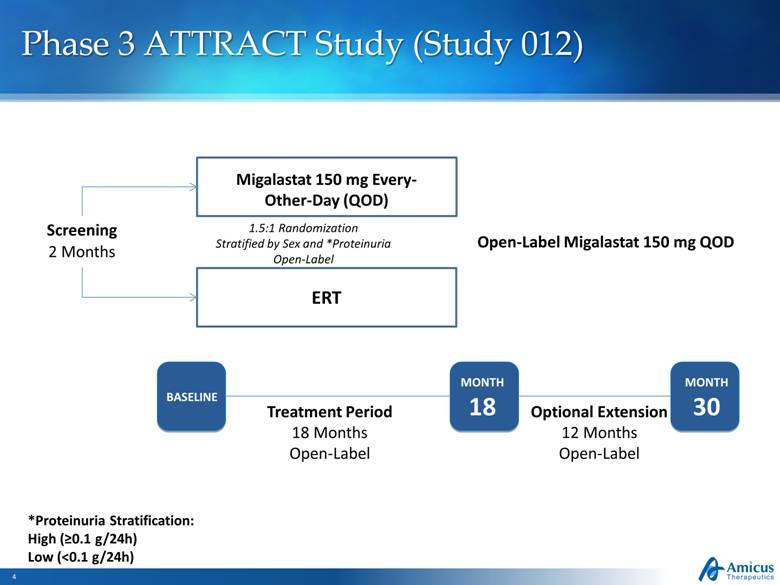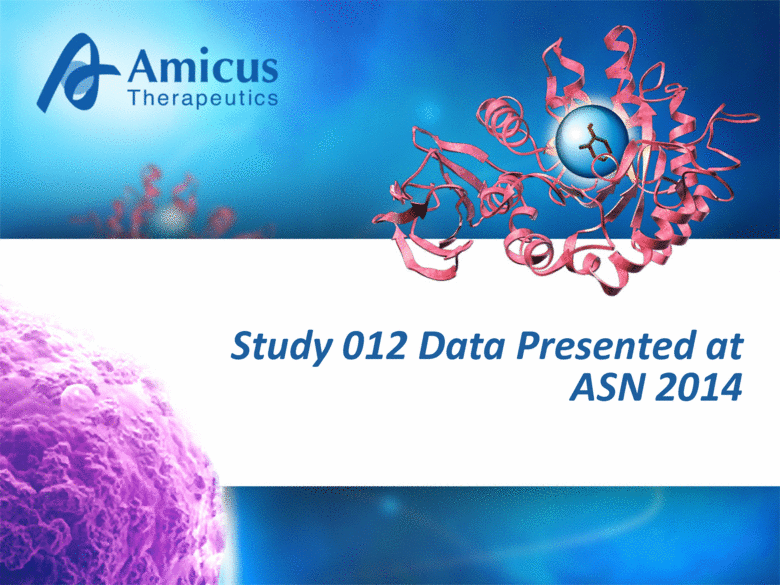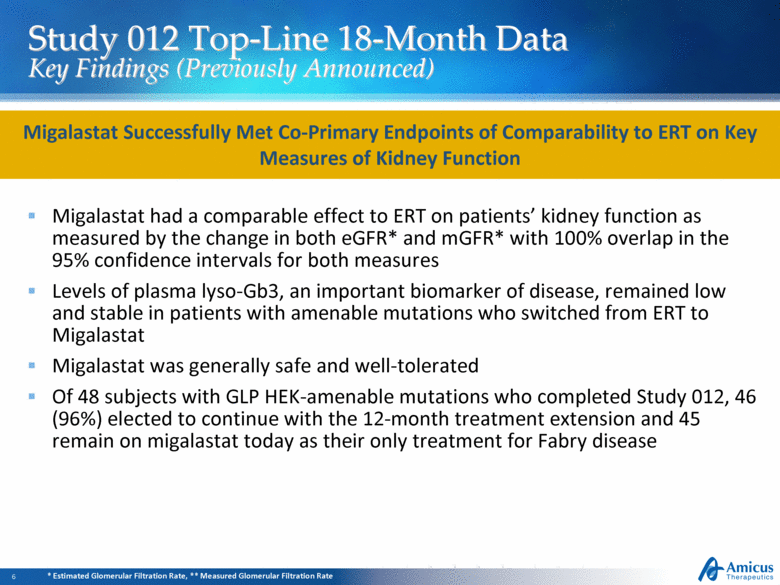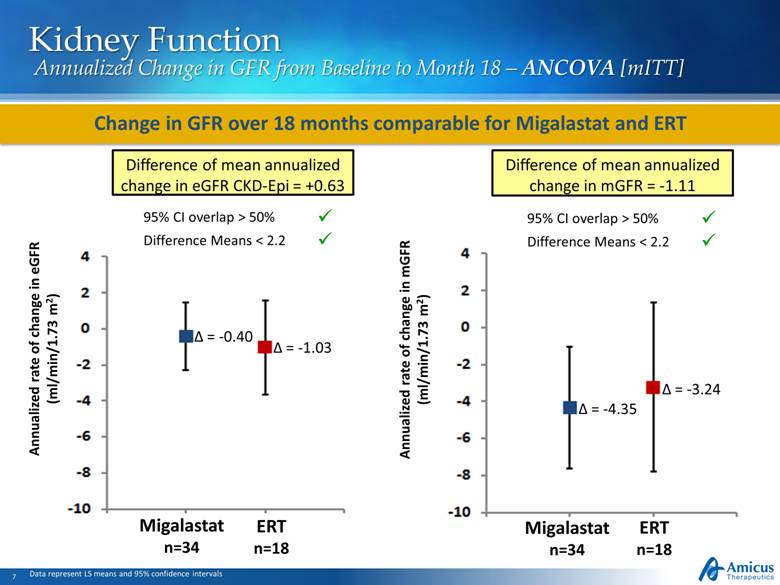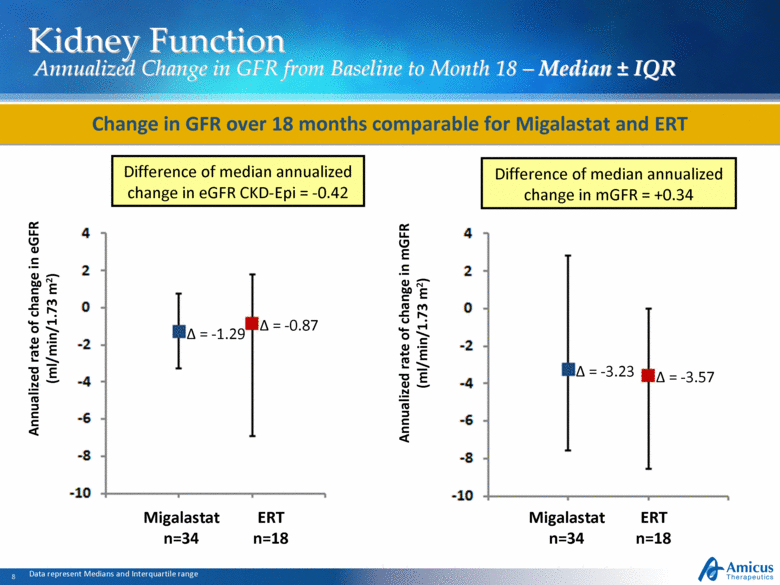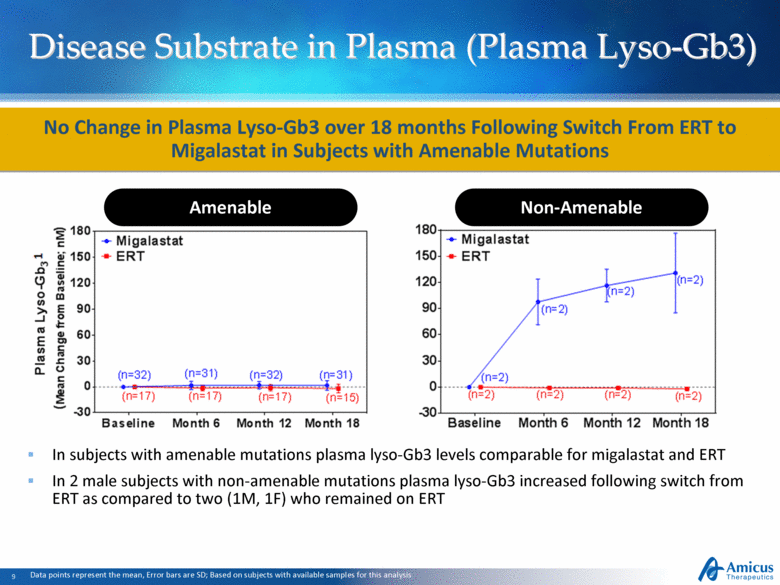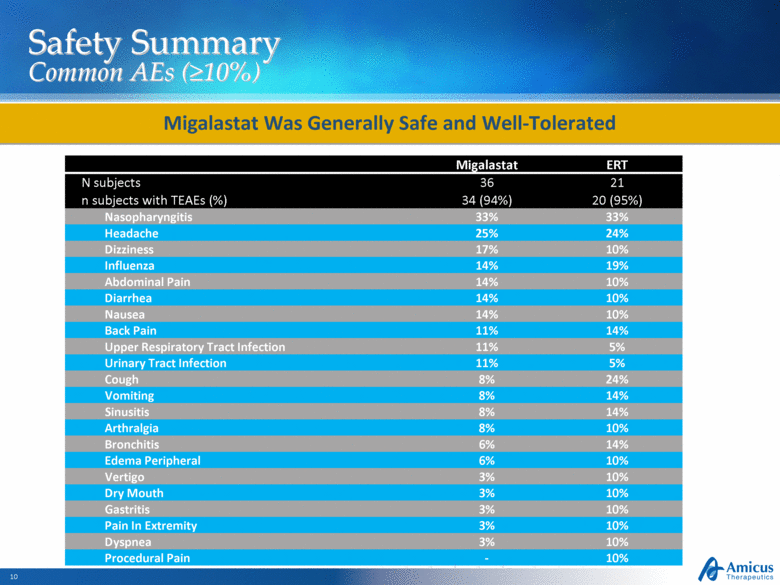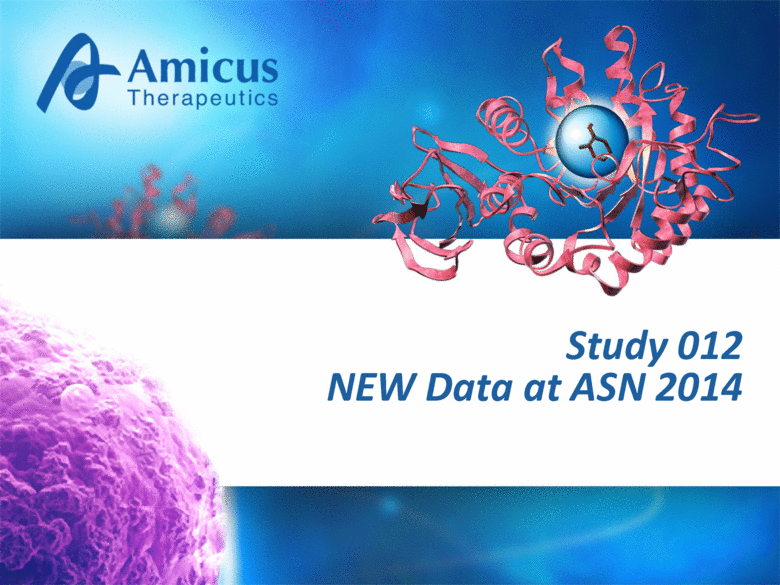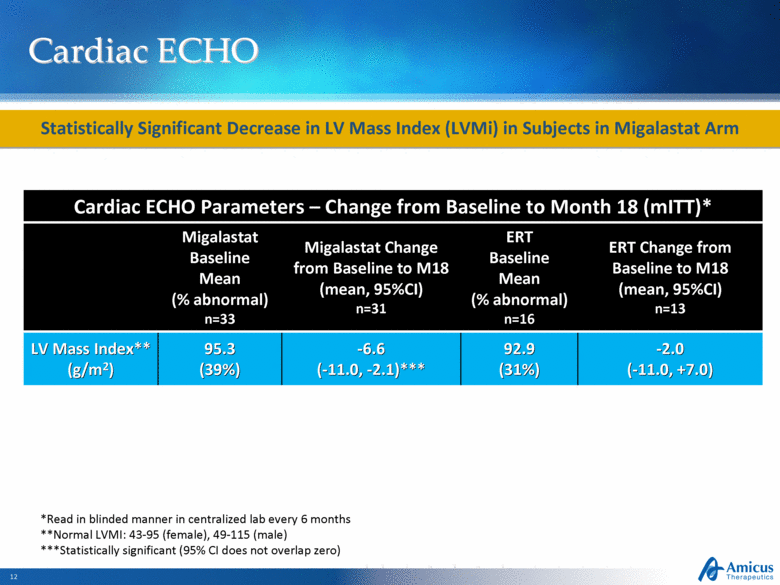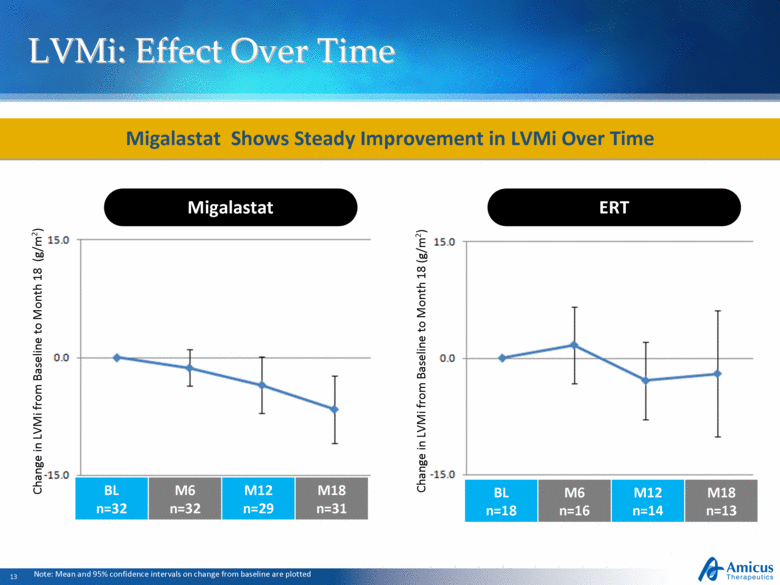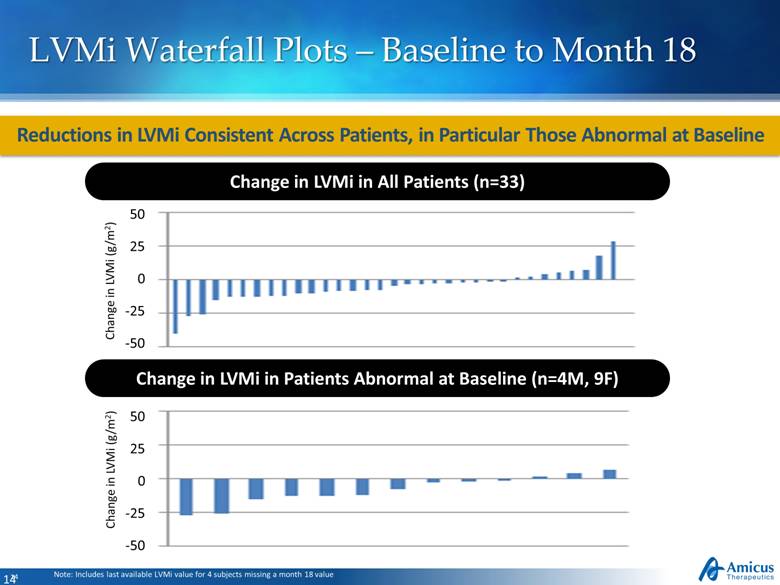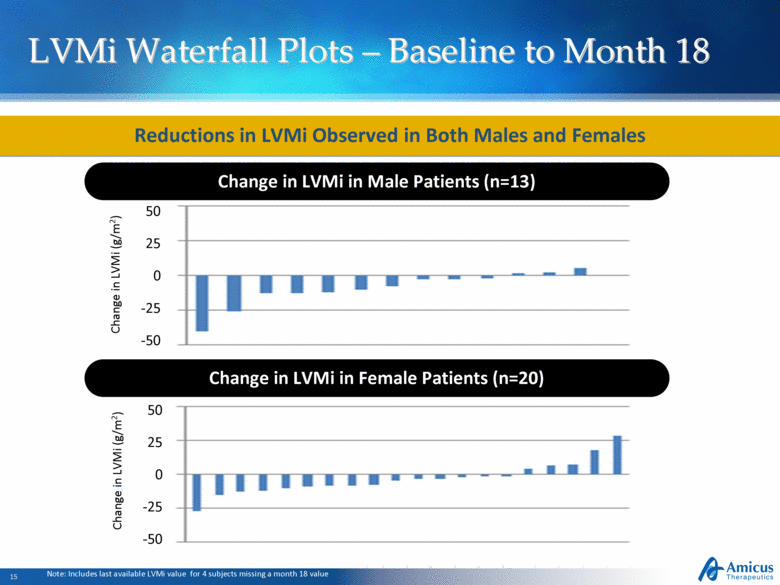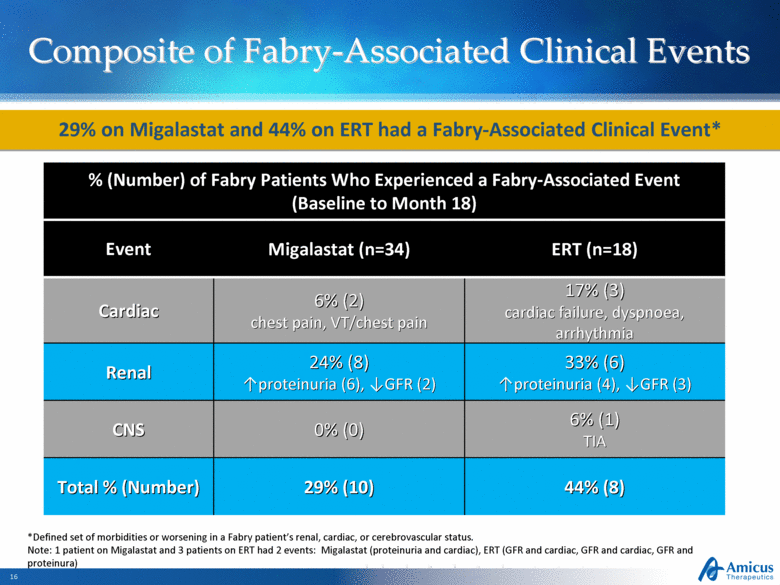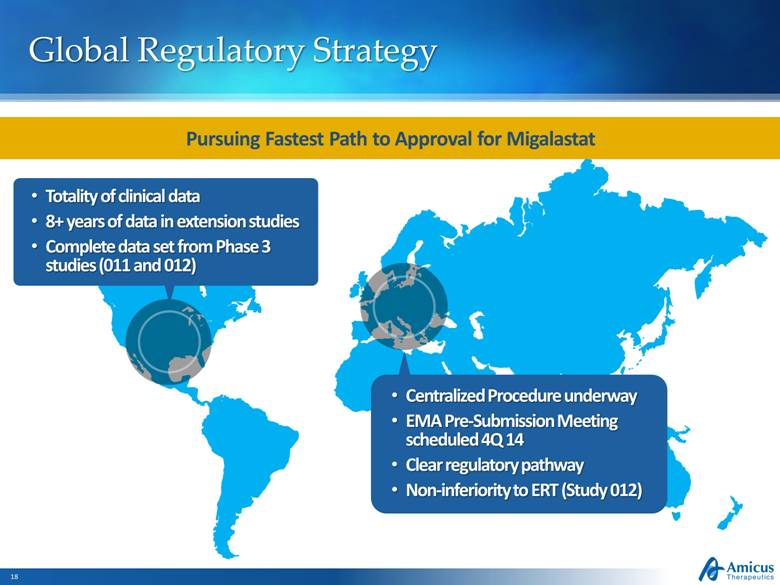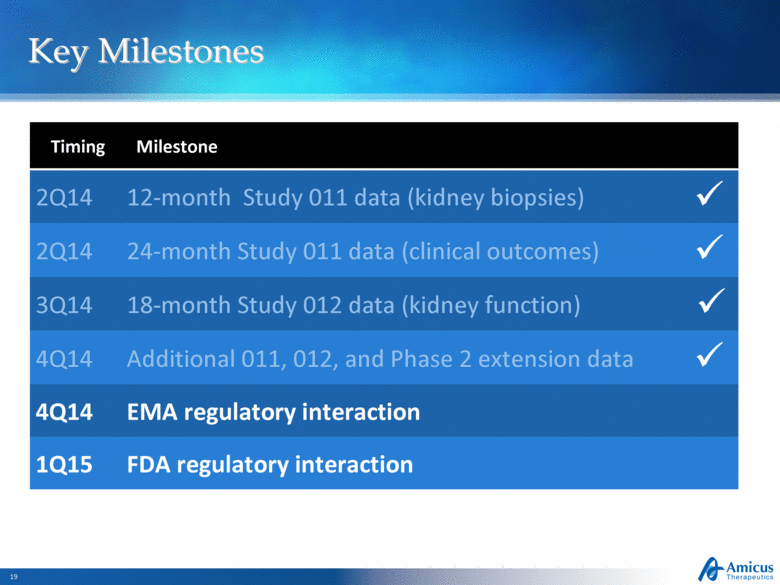Form 8-K AMICUS THERAPEUTICS INC For: Nov 15
�
�
UNITED STATES
SECURITIES AND EXCHANGE COMMISSION
Washington, D.C. 20549
�
FORM�8-K
�
CURRENT REPORT
Pursuant to Section�13 or 15(d)�of the Securities Exchange Act of 1934
�
Date of Report (Date of earliest event reported): November�15, 2014
�
AMICUS THERAPEUTICS,�INC.
(Exact name of registrant as specified in its charter)
�
|
Delaware |
� |
001-33497 |
� |
71-0869350 |
|
(State or other Jurisdiction of Incorporation) |
� |
(Commission File Number) |
� |
(IRS Employer Identification No.) |
�
|
1 Cedar Brook Drive, Cranbury, NJ |
� |
08512 |
|
(Address of Principal Executive Offices) |
� |
(Zip Code) |
�
Registrant�s telephone number, including area code: (609) 662-2000
�
�
(Former name or former address if changed since last report.)
�
Check the appropriate box below if the Form�8-K filing is intended to simultaneously satisfy the filing obligation of the registrant under any of the following provisions:
�
o������������������������� Written communications pursuant to Rule�425 under the Securities Act (17 CFR 230.425)
�
o������������������������� Soliciting material pursuant to Rule�14a-12 under the Exchange Act (17 CFR 240.14a-12)
�
o������������������������� Pre-commencement communications pursuant to Rule�14d-2(b)�under the Exchange Act (17 CFR 240.14d-2(b))
�
o������������������������� Pre-commencement communications pursuant to Rule�13e-4(c)�under the Exchange Act (17 CFR 240.13e-4(c))
�
�
�
�
Item�8.01. Other Events.
�
On November�15, 2014, the Company issued a press release announcing positive Phase 3 data on Cardiac and Composite Endpoints from Fabry Monotherapy Study 012 at the American Society of Nephrology conference in Philadelphia, PA. A copy of this press release is attached hereto as Exhibit�99.1.� A copy of the American Society of Nephrology presentation materials dated November�15, 2014 is attached hereto as Exhibit�99.2.
�
Item 9.01. Financial Statements and Exhibits.
�
(d)�Exhibits:� The Exhibit�Index annexed hereto is incorporated herein by reference.
�
|
Exhibit |
� |
Description |
|
99.1 |
� |
Press Release dated November�15, 2014 titled �Amicus Therapeutics Announces Positive Phase 3 Data on Cardiac and Composite Endpoints from Fabry Monotherapy Study 012 at American Society of Nephrology.� |
|
� |
� |
� |
|
99.2 |
� |
American Society of Nephrology presentation materials dated November�15, 2014 |
�
�
SIGNATURES
�
Pursuant to the requirements of the Securities Exchange Act of 1934, the registrant has duly caused this report to be signed on its behalf by the undersigned hereunto duly authorized.
�
|
� |
� |
AMICUS THERAPEUTICS,�INC. | |
|
� |
� |
� | |
|
Date: November�17, 2014 |
� |
By: |
/s/ WILLIAM D. BAIRD III |
|
� |
� |
Name: |
William D. Baird III |
|
� |
� |
Title: |
Chief Financial Officer |
�
�
EXHIBIT�INDEX
�
|
Exhibit�No. |
� |
Description |
|
99.1 |
� |
Press Release dated November�15, 2014 titled �Amicus Therapeutics Announces Positive Phase 3 Data on Cardiac and Composite Endpoints from Fabry Monotherapy Study 012 at American Society of Nephrology.� |
|
� |
� |
� |
|
99.2 |
� |
American Society of Nephrology presentation materials dated November�15, 2014 |
�
Exhibit�99.1
�

�
Amicus Therapeutics Announces Positive Phase 3 Data on Cardiac and Composite Endpoints from Fabry Monotherapy Study 012 at American Society of Nephrology
�
Statistically Significant Improvement in Key Cardiac Parameter in Patients Switched from Enzyme Replacement Therapies to Migalastat
�
CRANBURY, NJ, and PHILADELPHIA, PA November�15, 2014 � Amicus Therapeutics (Nasdaq: FOLD), a biopharmaceutical company at the forefront of therapies for rare and orphan diseases, today announced additional positive data on important secondary endpoints from its second Phase 3 study (Study 012) of the oral small molecule chaperone migalastat HCl (�migalastat�) for Fabry disease. In a poster(1)�at the American Society of Nephrology (ASN) Kidney Week 2014, results were presented from Fabry patients with amenable mutations in Study 012 who switched from standard of care enzyme replacement therapy (ERT) to migalastat as their only therapy for Fabry disease. A slide presentation featuring these data is also available at http://ir.amicustherapeutics.com/events.cfm.
�
Data from the Fabry Registry indicate that the leading cause of death in patients is from cardiac complications(2). In Study 012, patients who switched from ERT to migalastat showed a statistically significant decrease from baseline to month 18 in left ventricular mass index (LVMi). LVMi is a measure of cardiac hypertrophy, an increase in the size of the heart that has been associated with an increased risk of cardiac events in Fabry patients.
�
�Cardiac disease represents a major cause of morbidity and mortality in Fabry patients that is not adequately addressed with currently available treatment,� said Professor Ales Linhart, MD,�PhD, a leading expert in the cardiac manifestations of Fabry disease from Charles University of Prague. �The data showing further regression of left ventricular mass in patients switched from ERT to migalastat in this study are very promising since in other cardiac conditions a reduction of cardiac mass typically translates to significant improvements in long term outcomes.�
�
Cardiac ECHO Parameters � Change from Baseline to Month 18*
�
|
� |
� |
Migalastat�Baseline |
� |
Migalastat�Change |
� |
ERT�Baseline�Mean |
� |
ERT�Change |
� |
|
Left Ventricular Mass Index (LVMI) (g/m2)** |
� |
95.3 |
� |
-6.6 |
� |
92.9 |
� |
-2.0 |
� |
�
*Read in blinded manner in centralized lab every 6 months **Normal LVMI: 43-95 (female), 49-115 (male) ***Statistically significant (95% CI does not overlap zero)
�
Migalastat also demonstrated a favorable outcome in a composite endpoint of Fabry-associated clinical events, which are a defined set of morbidities or worsening in a Fabry patient�s renal, cardiac, or cerebrovascular status. Fabry-associated clinical events were observed in 29% (10/34) of patients who switched from ERT to migalastat and in 44% (8/18) of patients who remained on ERT.
�
Dr.�Kathy Nicholls, nephrologist from Royal Melbourne Hospital and University of Melbourne, and investigator with 7 years experience in treating Fabry patients in clinical studies of migalastat, said �Fabry patients randomized to switch from ERT to Migalastat showed stability in renal function at least comparable to those who continued on ERT. The new data on cardiac mass and clinical events are encouraging. An oral therapy for Fabry disease is very attractive to patients.�
�
Study 012 was designed to compare the safety and efficacy of migalastat to ERT in patients with Fabry disease who have amenable mutations. As previously reported, migalastat successfully met both co-primary endpoints of comparability to ERT on both key measures of kidney function in Study 012.
�
�
�These data are profoundly important,� said John F. Crowley, Chairman and Chief Executive Officer of Amicus Therapeutics,�Inc. �Migalastat is not oral ERT. It is a unique small molecule with a novel mechanism of action designed to restore enzyme activity in key cell types and organs of disease in Fabry patients with amenable mutations. Migalastat has previously shown a consistent and durable effect on substrate reduction and stabilization of kidney function.�Now, for the first time, we are presenting data at ASN that demonstrate migalastat has a significant effect on a key cardiac manifestation of the disease. We intend to seek approval of migalastat in both the European Union and in the U.S. We are on track to hold our pre-submission meeting with European regulators this quarter, and expect to interact with the FDA in early 2015. Our goal is to make migalastat monotherapy available for all Fabry patients with amenable mutations as quickly as possible.�
�
About Study 012
�
Study 012 was a Phase 3, open-label study that compared oral migalastat to standard-of-care enzyme replacement therapies (ERTs) for Fabry disease (Fabrazyme� and Replagal�). The study enrolled 60 patients (26 males and 34 females) with Fabry disease with amenable mutations in a clinical trial assay who had been treated with ERT for a minimum of 12 months prior to study entry. These patients were randomized 1.5:1 to switch to migalastat (36 patients) or remain on ERT (24 patients) for the primary 18-month treatment period, after which they were eligible to receive migalastat in a 12-month extension phase.
�
The co-primary outcome measures were the mean annualized changes in estimated glomerular filtration rate (eGFR) and measured (iohexol) GFR (mGFR) assessed by descriptive comparisons of migalastat and ERT over 18 months. Secondary outcome measures included cardiac function assessed by echocardiography, as well as a composite of Fabry-associated clinical events (i.e. renal, cardiac, or cerebrovascular).
�
About GLP HEK-Amenable Mutations
�
Amenable mutations are defined as having an absolute increase of 3% of wild type alpha-Gal A enzyme activity and a relative increase of 20% when exposed to migalastat in a cell-based in vitro assay. All patients enrolled in Study 012 had amenable mutations in the clinical trial HEK assay available at study initiation (�clinical trial assay�). Following the completion of enrollment, a GLP HEK assay was developed with a third party to measure the criteria for amenability with more quality control and rigor. However, approximately 10% of mutations in the HEK database switched categorization between �amenable� and �non-amenable� when moving from the clinical trial assay to the GLP HEK assay. Therefore there were changes in categorization from amenable to non-amenable in 4 patients in Study 012.
�
Overall based on results from mutations tested in the GLP HEK assay, Amicus continues to believe that approximately 30% to 50% of the Fabry population have mutations that are amenable to migalastat.
�
About Amicus Therapeutics
�
Amicus Therapeutics (Nasdaq: FOLD) is a biopharmaceutical company at the forefront of therapies for rare and orphan diseases. The Company is developing novel, first-in-class treatments for a broad range of human genetic diseases, with a focus on delivering new benefits to individuals with lysosomal storage diseases. Amicus� lead programs include the small molecule pharmacological chaperones migalastat as a monotherapy and in combination with enzyme replacement therapy (ERT) for Fabry disease; and AT2220 (duvoglustat) in combination with ERT for Pompe disease.
�
(1)Nicholls, et. al., American Society of Nephrology 2014. Migalastat and Enzyme Replacement Therapy Have Comparable Effects on Renal Function in Fabry Disease: Phase 3 Study Results.
(2)Mehta 2009
�
Forward-Looking Statements
�
This press release contains, and the accompanying slide presentation contains, �forward-looking statements� within the meaning of the Private Securities Litigation Reform Act of 1995 relating to preclinical and clinical development of Amicus� candidate drug products, the timing and reporting of results from preclinical studies and clinical trials evaluating Amicus� candidate drug products and the projected cash position for the Company. Words such as, but not limited to, �look forward to,� �believe,� �expect,� �anticipate,� �estimate,� �intend,� �potential,� �plan,� �targets,� �likely,� �may,� �will,� �would,� �should� and �could,� and similar expressions or words identify forward-looking statements. Such forward-looking statements are based upon current expectations that involve risks, changes in circumstances, assumptions and uncertainties. The inclusion of forward-looking statements should not be regarded as a representation by Amicus that any of its plans will be achieved. Any or all of the forward-looking statements in this press release may turn out to be wrong. They can be affected by inaccurate assumptions Amicus might make or by known or unknown risks and uncertainties. For example, with respect to statements regarding the goals, progress, timing and outcomes of discussions with regulatory authorities and the potential goals, progress, timing and results of preclinical studies and clinical trials, actual results may differ materially from those set forth in this release due to the risks and uncertainties inherent in the business of Amicus, including, without limitation: the potential that results of clinical or pre-clinical studies indicate that the product candidates are unsafe or ineffective; the potential that it may be difficult to enroll patients in our clinical trials; the potential that regulatory authorities may not grant or may delay approval for our product candidates; the potential that preclinical and clinical studies could be delayed because we identify serious side effects or other safety issues; the potential that we will need additional funding to complete all of our
�
�
studies and, our dependence on third parties in the conduct of our clinical studies. Further, the results of earlier preclinical studies and/or clinical trials may not be predictive of future results. With respect to statements regarding projections of the Company�s cash position, actual results may differ based on market factors and the Company�s ability to execute its operational and budget plans. In addition, all forward looking statements are subject to other risks detailed in our Annual Report on Form�10-K for the year ended December�31, 2013. You are cautioned not to place undue reliance on these forward-looking statements, which speak only as of the date hereof. All forward-looking statements are qualified in their entirety by this cautionary statement, and Amicus undertakes no obligation to revise or update this news release to reflect events or circumstances after the date hereof. This caution is made under the safe harbor provisions of Section�21E of the Private Securities Litigation Reform Act of 1995.
�
CONTACTS:
�
Investors/Media:
�
Amicus Therapeutics
Sara Pellegrino
Director,�Investor Relations
(609) 662-5044
�
Media:
�
Pure Communications
Dan Budwick
(973) 271-6085
�
FOLD�G
�
Exhibit 99.2
�
|
|
American Society of Nephrology (ASN) Migalastat Monotherapy Phase 3 Data November 15, 2014 |
�
|
|
Safe Harbor This presentation contains �forward-looking statements� within the meaning of the Private Securities Litigation Reform Act of 1995 relating to business, operations and financial conditions of Amicus including but not limited to preclinical and clinical development of Amicus� candidate drug products, cash runway, ongoing collaborations and the timing and reporting of results from clinical trials evaluating Amicus� candidate drug products. Words such as, but not limited to, �look forward to,� �believe,� �expect,� �anticipate,� �estimate,� �intend,� �plan,� �would,� �should� and �could,� and similar expressions or words, identify forward-looking statements. Although Amicus believes the expectations reflected in such forward-looking statements are based upon reasonable assumptions, there can be no assurance that its expectations will be realized. Actual results could differ materially from those projected in Amicus� forward-looking statements due to numerous known and unknown risks and uncertainties, including the �Risk Factors� described in our Annual Report on Form 10-K for the year ended December 31, 2013. All forward-looking statements are qualified in their entirety by this cautionary statement, and Amicus undertakes no obligation to revise or update this presentation to reflect events or circumstances after the date hereof. |
�
|
|
Fabry Disease Overview Deficiency of lysosomal enzyme -Gal A leading to GL-3 accumulation Heterogeneous (>800 known mutations) Symptoms include pain, gastrointestinal problems, angiokeratomas Cardiac complications, renal failure, stroke are leading causes of morbidity Recent Fabry Registry data indicate cardiac complications are leading cause of death in patients1,2 Left ventricular hypertrophy is a hallmark of Fabry cardiomyopathy, associated with increased risk of cardiac events and mortality3 Natural history data indicates left ventricular mass increases progressively in untreated patients4,5 Kidney GL-3 Fatal lysosomal storage disease with significant unmet needs despite available treatment options 1Mehta 2009, 2Waldek 2009, 3Patel 2011, 4Kampmann 2008, 5Germain 2013 |
�
|
|
1.5:1 Randomization Stratified by Sex and *Proteinuria Open-Label Migalastat 150 mg Every-Other-Day (QOD) Open-Label Migalastat 150 mg QOD MONTH 18 MONTH 30 BASELINE Optional Extension 12 Months Open-Label Treatment Period 18 Months Open-Label Screening 2 Months ERT Slide 4 *Proteinuria Stratification: High (>0.1 g/24h) Low (<0.1 g/24h) Phase 3 ATTRACT Study (Study 012) |
�
|
|
Study 012 Data Presented at ASN 2014 |
�
|
|
Study 012 Top-Line 18-Month Data Key Findings (Previously Announced) Migalastat had a comparable effect to ERT on patients� kidney function as measured by the change in both eGFR* and mGFR* with 100% overlap in the 95% confidence intervals for both measures Levels of plasma lyso-Gb3, an important biomarker of disease, remained low and stable in patients with amenable mutations who switched from ERT to Migalastat Migalastat was generally safe and well-tolerated Of 48 subjects with GLP HEK-amenable mutations who completed Study 012, 46 (96%) elected to continue with the 12-month treatment extension and 45 remain on migalastat today as their only treatment for Fabry disease Migalastat Successfully Met Co-Primary Endpoints of Comparability to ERT on Key Measures of Kidney Function * Estimated Glomerular Filtration Rate, ** Measured Glomerular Filtration Rate |
�
|
|
Kidney Function Annualized Change in GFR from Baseline to Month 18 � ANCOVA [mITT] Annualized rate of change in mGFR (ml/min/1.73 m2) Difference of mean annualized change in mGFR = -1.11 Migalastat n=34 ERT n=18� = -4.35� = -3.24 Difference of mean annualized change in eGFR CKD-Epi = +0.63 Annualized rate of change in eGFR (ml/min/1.73 m2) Migalastat n=34 ERT n=18� = -0.40� = -1.03 Data represent LS means and 95% confidence intervals Change in GFR over 18 months comparable for Migalastat and ERT 95% CI overlap > 50% Difference Means < 2.2 95% CI overlap > 50% Difference Means < 2.2 |
�
|
|
Kidney Function Annualized Change in GFR from Baseline to Month 18 � Median � IQR Annualized rate of change in mGFR (ml/min/1.73 m2) Difference of median annualized change in mGFR = +0.34 Migalastat n=34 ERT n=18� = -3.23� = -3.57 Difference of median annualized change in eGFR CKD-Epi = -0.42 Annualized rate of change in eGFR (ml/min/1.73 m2) Migalastat n=34 ERT n=18� = -1.29� = -0.87 Data represent Medians and Interquartile range Change in GFR over 18 months comparable for Migalastat and ERT |
�
|
|
Disease Substrate in Plasma (Plasma Lyso-Gb3) Data points represent the mean, Error bars are SD; Based on subjects with available samples for this analysis No Change in Plasma Lyso-Gb3 over 18 months Following Switch From ERT to Migalastat in Subjects with Amenable Mutations In subjects with amenable mutations plasma lyso-Gb3 levels comparable for migalastat and ERT In 2 male subjects with non-amenable mutations plasma lyso-Gb3 increased following switch from ERT as compared to two (1M, 1F) who remained on ERT Amenable Non-Amenable |
�
|
|
Safety Summary Common AEs (>10%) Migalastat Was Generally Safe and Well-Tolerated Migalastat ERT N subjects 36 21 n subjects with TEAEs (%) 34 (94%) 20 (95%) Nasopharyngitis 33% 33% Headache 25% 24% Dizziness 17% 10% Influenza 14% 19% Abdominal Pain 14% 10% Diarrhea 14% 10% Nausea 14% 10% Back Pain 11% 14% Upper Respiratory Tract Infection 11% 5% Urinary Tract Infection 11% 5% Cough 8% 24% Vomiting 8% 14% Sinusitis 8% 14% Arthralgia 8% 10% Bronchitis 6% 14% Edema Peripheral 6% 10% Vertigo 3% 10% Dry Mouth 3% 10% Gastritis 3% 10% Pain In Extremity 3% 10% Dyspnea 3% 10% Procedural Pain - 10% |
�
|
|
Study 012 NEW Data at ASN 2014 |
�
|
|
Cardiac ECHO Cardiac ECHO Parameters � Change from Baseline to Month 18 (mITT)* Migalastat Baseline Mean (% abnormal) n=33 Migalastat Change from Baseline to M18 (mean, 95%CI) n=31 ERT Baseline Mean (% abnormal) n=16 ERT Change from Baseline to M18 (mean, 95%CI) n=13 LV Mass Index** (g/m2) 95.3 (39%) -6.6 (-11.0, -2.1)*** 92.9 (31%) -2.0 (-11.0, +7.0) Statistically Significant Decrease in LV Mass Index (LVMi) in Subjects in Migalastat Arm *Read in blinded manner in centralized lab every 6 months **Normal LVMI: 43-95 (female), 49-115 (male) ***Statistically significant (95% CI does not overlap zero) |
�
|
|
Migalastat Shows Steady Improvement in LVMi Over Time LVMi: Effect Over Time BL n=32 M6 n=32 M12 n=29 M18 n=31 Migalastat Change in LVMi from Baseline to Month 18 (g/m2) ERT Change in LVMi from Baseline to Month 18 (g/m2) BL n=18 M6 n=16 M12 n=14 M18 n=13 Note: Mean and 95% confidence intervals on change from baseline are plotted Migalastat ERT |
�
|
|
LVMi Waterfall Plots � Baseline to Month 18 ALL (n=33) Abnormal at Baseline (n=4M, 9F) 14 Reductions in LVMi Consistent Across Patients, in Particular Those Abnormal at Baseline Change in LVMi (g/m2) Change in LVMi (g/m2) Change in LVMi in All Patients (n=33) Change in LVMi in Patients Abnormal at Baseline (n=4M, 9F) Note: Includes last available LVMi value for 4 subjects missing a month 18 value 50 25 0 -25 -50 50 25 0 -25 -50 |
�
|
|
LVMi Waterfall Plots � Baseline to Month 18 ALL (n=33) Abnormal at Baseline (n=4M, 9F) Reductions in LVMi Observed in Both Males and Females Change in LVMi in Male Patients (n=13) Females (n=20) Change in LVMi (g/m2) Change in LVMi (g/m2) Change in LVMi in Female Patients (n=20) Note: Includes last available LVMi value for 4 subjects missing a month 18 value 50 25 0 -25 -50 50 25 0 -25 -50 |
�
|
|
Composite of Fabry-Associated Clinical Events 29% on Migalastat and 44% on ERT had a Fabry-Associated Clinical Event* % (Number) of Fabry Patients Who Experienced a Fabry-Associated Event (Baseline to Month 18) Event Migalastat (n=34) ERT (n=18) Cardiac 6% (2) chest pain, VT/chest pain 17% (3) cardiac failure, dyspnoea, arrhythmia Renal 24% (8) proteinuria (6), GFR (2) 33% (6) proteinuria (4), GFR (3) CNS 0% (0) 6% (1) TIA Total % (Number) 29% (10) 44% (8) *Defined set of morbidities or worsening in a Fabry patient�s renal, cardiac, or cerebrovascular status. Note: 1 patient on Migalastat and 3 patients on ERT had 2 events: Migalastat (proteinuria and cardiac), ERT (GFR and cardiac, GFR and cardiac, GFR and proteinura) |
�
|
|
Migalastat Monotherapy Experience for Fabry Information as of November 2014. All patients are receiving investigational drug, migalastat HCl, as part of ongoing clinical trials *Retention defined as # of patients who completed a study and chose to enter extension, e.g., Study 011 12-mo into 24-mo extension Total patients who have ever taken migalastat: 143 Total patient years of therapy: 403 Maximum years on therapy: 8.8 Average retention rate into next study: 96% * Patients taking migalastat today as only therapy: 95 97 Patients Today Take Migalastat HCl as Only Therapy for Fabry Disease1 |
�
|
|
Global Regulatory Strategy Totality of clinical data 8+ years of data in extension studies Complete data set from Phase 3 studies (011 and 012) Centralized Procedure underway EMA Pre-Submission Meeting scheduled 4Q 14 Clear regulatory pathway Non-inferiority to ERT (Study 012) Pursuing Fastest Path to Approval for Migalastat |
�
|
|
Key Milestones Timing Milestone 2Q14 12-month Study 011 data (kidney biopsies) 2Q14 24-month Study 011 data (clinical outcomes) 3Q14 18-month Study 012 data (kidney function) 4Q14 Additional 011, 012, and Phase 2 extension data 4Q14 EMA regulatory interaction 1Q15 FDA regulatory interaction |
�
|
|
American Society of Nephrology (ASN) Migalastat Monotherapy Phase 3 Data November 15, 2014 |
�
�
Serious News for Serious Traders! Try StreetInsider.com Premium Free!
You May Also Be Interested In
- Meta shares dip on softer Q2 revenue guidance, elevated AI spending plans
- Dimensional Fund Advisors Ltd. : Form 8.3 - Irish Residential Properties REIT PLC
- ISC2 Research Finds Some Progress, But More Needs to be Done to Support Women in Cybersecurity
Create E-mail Alert Related Categories
SEC FilingsSign up for StreetInsider Free!
Receive full access to all new and archived articles, unlimited portfolio tracking, e-mail alerts, custom newswires and RSS feeds - and more!



 Tweet
Tweet Share
Share